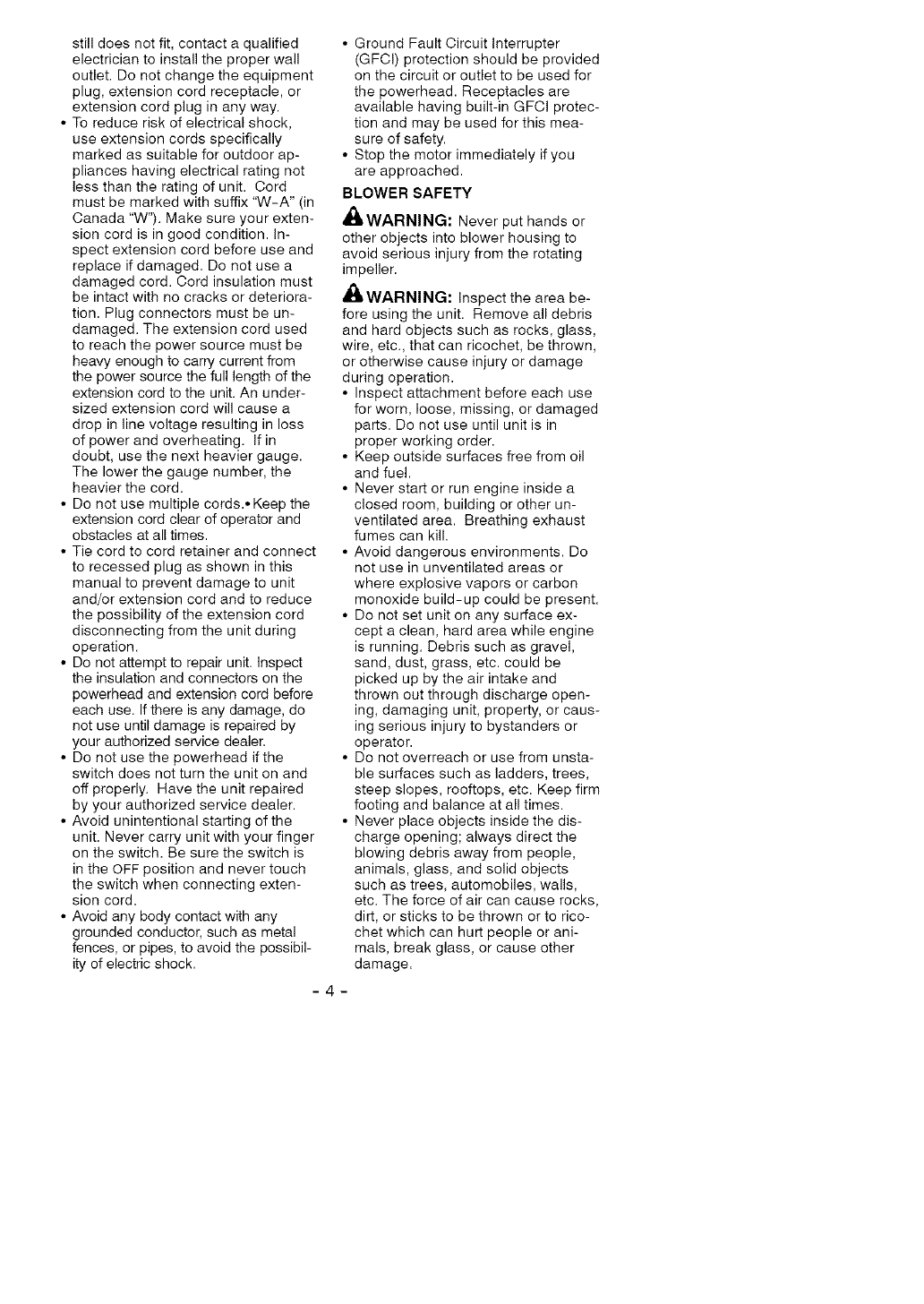
still does not fit, contact a qualified
electrician to install the proper wall
outlet. Do not change the equipment
plug, extension cord receptacle, or
extension cord plug in any way.
• To reduce risk of electrical shock,
use extension cords specifically
marked as suitable for outdoor ap-
pliances having electrical rating not
less than the rating of unit. Cord
must be marked with suffix "W-A" (in
Canada "W"). Make sure your exten-
sion cord is in good condition. In-
spect extension cord before use and
replace if damaged. Do not use a
damaged cord. Cord insulation must
be intact with no cracks or deteriora-
tion. Plug connectors must be un-
damaged. The extension cord used
to reach the power source must be
heavy enough to carry current from
the power source the full length of the
extension cord to the unit. An under-
sized extension cord will cause a
drop in line voltage resulting in loss
of power and overheating. If in
doubt, use the next heavier gauge.
The lower the gauge number, the
heavier the cord.
• Do not use multiple cords..Keep the
extension cord clear of operator and
obstacles at all times.
• Tie cord to cord retainer and connect
to recessed plug as shown in this
manual to prevent damage to unit
and/or extension cord and to reduce
the possibility of the extension cord
disconnecting from the unit during
operation.
• Do not attempt to repair unit. Inspect
the insulation and connectors on the
powerhead and extension cord before
each use. If there is any damage, do
not use until damage is repaired by
your authorized service dealer.
• Do not use the powerhead if the
switch does not turn the unit on and
off properly. Have the unit repaired
by your authorized service dealer.
• Avoid unintentional starting of the
unit. Never carry unit with your finger
on the switch. Be sure the switch is
in the OFF position and never touch
the switch when connecting exten-
sion cord.
• Avoid any body contact with any
grounded conductor, such as metal
fences, or pipes, to avoid the possibil-
ity of electric shock.
• Ground Fault Circuit Interrupter
(GFCI) protection should be provided
on the circuit or outlet to be used for
the powerhead. Receptacles are
available having built-in GFCI protec-
tion and may be used for this mea-
sure of safety.
• Stop the motor immediately if you
are approached.
BLOWER SAFETY
_WARNING: Never put hands or
other objects into blower housing to
avoid serious injury from the rotating
impeller.
A_, WARNING: Inspect the area be-
fore using the unit. Remove all debris
and hard objects such as rocks, glass,
wire, etc., that can ricochet, be thrown,
or otherwise cause injury or damage
during operation.
• Inspect attachment before each use
for worn, loose, missing, or damaged
parts. Do not use until unit is in
proper working order.
• Keep outside surfaces free from oil
and fuel.
• Never start or run engine inside a
closed room, building or other un-
ventilated area. Breathing exhaust
fumes can kill.
• Avoid dangerous environments. Do
not use in unventilated areas or
where explosive vapors or carbon
monoxide build-up could be present.
• Do not set unit on any surface ex-
cept a clean, hard area while engine
is running. Debris such as gravel,
sand, dust, grass, etc. could be
picked up by the air intake and
thrown out through discharge open-
ing, damaging unit, property, or caus-
ing serious injury to bystanders or
operator.
• Do not overreach or use from unsta-
ble surfaces such as ladders, trees,
steep slopes, rooftops, etc. Keep firm
footing and balance at all times.
• Never place objects inside the dis-
charge opening; always direct the
blowing debris away from people,
animals, glass, and solid objects
such as trees, automobiles, walls,
etc. The force of air can cause rocks,
dirt, or sticks to be thrown or to rico-
chet which can hurt people or ani-
mals, break glass, or cause other
damage.
-4-










